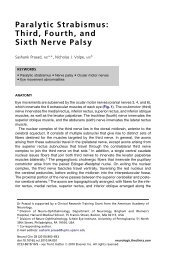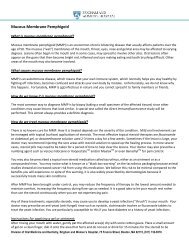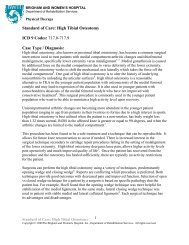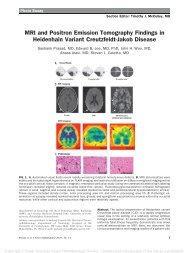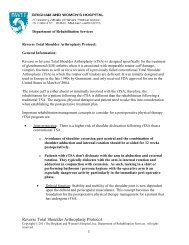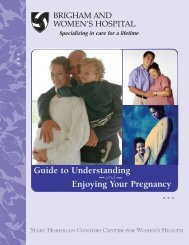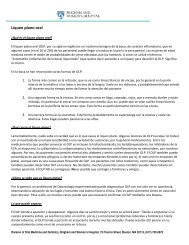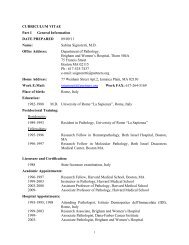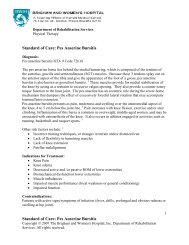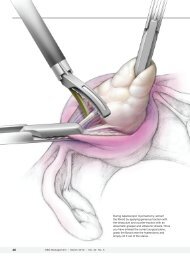Pelvic Girdle Pain - Brigham and Women's Hospital
Pelvic Girdle Pain - Brigham and Women's Hospital
Pelvic Girdle Pain - Brigham and Women's Hospital
You also want an ePaper? Increase the reach of your titles
YUMPU automatically turns print PDFs into web optimized ePapers that Google loves.
BRIGHAM AND WOMEN’S HOSPITAL<br />
Department of Rehabilitation Services<br />
Physical Therapy<br />
St<strong>and</strong>ard of Care: <strong>Pelvic</strong> girdle pain<br />
Physical Therapy management of the patient with pelvic girdle pain (also referred to as posterior<br />
pelvic pain), ante <strong>and</strong> post partum, as well as, the non-pregnant population.<br />
Sacroiliac Joint <strong>Pain</strong> Syndromes in pregnancy.<br />
ICD 9 code: 719.45-pelvic joint pain, 720.2- sacroilitis, 724.3- sciatica, <strong>and</strong> 846.9- sacroiliac<br />
sprain<br />
Case Type / Diagnosis:<br />
<strong>Pelvic</strong> girdle pain (PGP) is defined by pain experienced between the posterior iliac crest <strong>and</strong> the<br />
gluteal fold, particularly in the vicinity of the sacroiliac joints (SIJ). 12 PGP is a specific form of<br />
low back pain (LBP) that can occur separately or concurrently with LBP. The pain may radiate<br />
in the posterior thigh <strong>and</strong> can occur in conjunction with/or separately in the symphysis. 1,2 PGP<br />
generally arises in relation to pregnancy, trauma, or reactive arthritis. The pain or functional<br />
disturbances in relation to PGP must be reproduced by specific clinical tests. 12<br />
The endurance capacity for st<strong>and</strong>ing, walking <strong>and</strong> sitting is diminished. 2 . Studies have indicated<br />
that 47-49% of pregnant women experience some form of back pain during their pregnancy.<br />
3,4 PGP has an incidence of 20% in the pregnant population. 2 When a pregnant patient presents<br />
with back pain it is critical to differentiate whether the patient has PGP or lumbar pain as each<br />
condition require a different treatment approach. PGP does not present with sensory changes or<br />
weakness, which differentiates PGP from lumbar radiculopathy. 4 Patients can have low back<br />
pain <strong>and</strong> PGP concurrently with an incidence of 8%. 4 . 4 PGP may occur at any time during<br />
pregnancy, however, on average it begins in the 18 th week of pregnancy. 5<br />
Albert described a classification system for pain based on location:<br />
• <strong>Pelvic</strong> girdle syndrome: Daily pain in all three pelvic joints confirmed with positive pain<br />
provoked by the tests from the equivalent joints.<br />
• Symphysiolysis: Daily pain in the pubic symphysis only, confirmed with positive pain<br />
provoked by the tests from the symphysis. Symphysiolysis does not imply an actual lysis.<br />
• One-sided sacroiliac syndrome: Daily pain from one sacroiliac joint confirmed with<br />
positive pain provoked by the tests from either joints.<br />
• Double-sided sacroiliac syndrome: Daily pain from both sacroiliac joints, confirmed<br />
with positive pain provoked by tests from both joints. 6<br />
The biomechanical cause of PGP is uncertain. Ostgaard states, “Posterior pelvic pain may be<br />
caused by a disturbance of the requested coordination of ligaments, muscles <strong>and</strong> joints in the<br />
posterior part of the pelvis. The problem is probably caused by the combined effect of the<br />
pregnancy hormones relaxin, estrogens <strong>and</strong> progesterone on the large ligaments in the posterior<br />
part of the pelvis. The result is an increased laxity, allowing a small but important instability in<br />
the pelvic joints.” 4 Studies have been done on women through their pregnancy up to 6 weeks<br />
post partum that examined the relationship between joint laxity, joint pain, <strong>and</strong> hormone levels.<br />
These studies found no significant differences between women who develop joint laxity <strong>and</strong><br />
those who did not. Therefore, concluding that joint laxity is always the cause of pain is<br />
debatable. 7 The effect of increased ligament laxity is a larger range of motion (ROM) in the<br />
pelvic joints. If this increased motion is not compensated for by altered neuromotor control, pain<br />
<strong>Pelvic</strong> <strong>Girdle</strong> <strong>Pain</strong><br />
1<br />
Copyright 2010 The <strong>Brigham</strong> <strong>and</strong> Women’s <strong>Hospital</strong>, Inc. Department of Rehabilitation<br />
Services. All right reserved.
may be the result. 2 A relationship exists between asymmetric SIJ laxity <strong>and</strong> pelvic pain. 1 An SIJ<br />
with more texture <strong>and</strong> more ridges <strong>and</strong> depressions is hypothesized to be more stable since it has<br />
a higher friction coefficient. It would be reasonable to conclude that patients with decreased SIJ<br />
friction have an increased likelihood of instability at the SIJ. However, there is no linear<br />
relationship between pain <strong>and</strong> increased ROM in the pelvic joint, therefore it appears some<br />
women can h<strong>and</strong>le increased laxity or ROM if adequate motion control or motor control is<br />
present. 8<br />
The role of the symphysis pubis in PGP is not clearly understood. Normally the symphysis<br />
pubis widens during pregnancy <strong>and</strong> is not considered clinically relevant. Ruptures of the<br />
symphysis pubis are defined as greater than one centimeter(cm), however 3-5cm separations can<br />
occur without symptoms, therefore separations are considered benign unless symptom<br />
producing. 9 Post-partum symphysis pubis separation assessment <strong>and</strong> management are not within<br />
the scope of this st<strong>and</strong>ard of care. Please refer to the st<strong>and</strong>ard of care for post-partum symphysis<br />
pain <strong>and</strong> / or separation for a discussion of management. Symphyseal pain has a weak<br />
correlation to PGP, however, given the anatomy of the pelvis some studies have found strong<br />
correlations between symphysis pain <strong>and</strong> SIJ pain. 3,10 Given that the pubis symphysis is a portion<br />
of the pelvic ring it is reasonable to consider that a dysfunction of the SIJ could affect the<br />
symphysis pubis <strong>and</strong> vice versa. It should be noted that patients might have separation without<br />
pain, <strong>and</strong> pain with or without instability.<br />
A model of SIJ stabilization has been proposed by Vleeming, which considers the histology,<br />
anatomy <strong>and</strong> biomechanics of the joint. The biomechanics are described using the terms “form<br />
closure”, “force closure” <strong>and</strong> “self-locking mechanism”. 1<br />
• Form closure is the idea that the shape <strong>and</strong> histology of the sacroiliac joint gives it<br />
stability. The sacrum is stabilized by the innomiantes because of its’ wedged shape, the<br />
cartilage in the joint is not smooth <strong>and</strong> there are bone extensions that protrude into the<br />
joint-ridges <strong>and</strong> grooves creating a stable situation where no extra forces are needed to<br />
maintain the system. 1<br />
• Force closure is the idea that outside forces are needed to assist in stabilization, such as<br />
ligament <strong>and</strong> muscle forces that compress the joint, thereby increasing friction. This is<br />
critical to allow for movement of the sacrum during activities such as, walking,<br />
transferring, stair use, <strong>and</strong> bending. During any movement the SIJ needs to be stable for<br />
the pelvis to function normally.<br />
• The combination of form <strong>and</strong> force closure is the “self-bracing” or “self-locking<br />
mechanism” of the SIJ. Form <strong>and</strong> force closure should be balanced. If a patient lacks<br />
form closure, perhaps because of genetics or anatomy, they will require more stability<br />
from muscles that assist in force closure. Someone with excellent form closure will<br />
have a stiffer sacroiliac joint <strong>and</strong> may be less susceptible to instability at the SIJ, <strong>and</strong><br />
less susceptible to hormonal induced laxity in pregnancy. 1<br />
Anatomically the force closing ligaments <strong>and</strong> muscles are as follows:<br />
Force Closure Ligaments: 8<br />
• Interosseous <strong>and</strong> Short Dorsal Sacroiliac Ligaments- These ligaments are important<br />
during sacral nutation.<br />
• The Sacrotuberous Ligaments – Because of their connection from the ischial tuberosity to<br />
the dorsal sacrum, they are influenced by muscle imbalances of the long head of the<br />
biceps femoris, gluteus maximus, <strong>and</strong> piriformis <strong>and</strong> from tension of the thoracolumbar<br />
fascia.<br />
<strong>Pelvic</strong> <strong>Girdle</strong> <strong>Pain</strong><br />
2<br />
Copyright 2010 The <strong>Brigham</strong> <strong>and</strong> Women’s <strong>Hospital</strong>, Inc. Department of Rehabilitation<br />
Services. All right reserved.
• Long Dorsal Sacroiliac Ligaments- Connect between the dorsal surface of the sacrum <strong>and</strong><br />
the posterior superior iliac spines.<br />
Force Closure Muscles: 8<br />
• Longitudinal Sling: Includes the multifidius muscles, the deep layer of the<br />
thoracolumbar fascia <strong>and</strong> the sacrotuberous ligament via the long head of the biceps<br />
femoris. Contraction of the spinal erectors can assist in force closure on the ipsilateral<br />
side or bilaterally if they are contracting bilaterally via the “pump it up phenomenon”.<br />
(Described below)<br />
This sling provides stability by:<br />
1) The contraction of the sacral part of the multifidus muscle thereby<br />
nutating the sacrum <strong>and</strong> increasing the tension of the interosseous <strong>and</strong> short dorsal<br />
SI ligaments.<br />
2) The thoracolumbar fascia is inflated by the contraction of the multifidus<br />
muscles, which increases the tension on the fascia thus “pumping it up”, which in<br />
turn increases force closure.<br />
• Posterior Sling: Includes the latissimus dorsi <strong>and</strong> the gluteus maximus.<br />
This sling provides stability through a simultaneous contraction of the gluteus maximus<br />
<strong>and</strong> the contralateral latissimus dorsi. They act on the sacrotuberous ligaments thereby<br />
compressing the SIJ.<br />
• Anterior Oblique Sling: Includes the external <strong>and</strong> internal oblique <strong>and</strong> the transverse<br />
abdominis.<br />
This sling provides stability through a contraction of these muscles which compresses the entire<br />
pelvic girdle providing support/stability similar to an abdominal binder. The European<br />
guidelines for PGP proposed that joint stability is not merely about how much a joint is moving<br />
or how resistant structures are, but more about motion control that allows load to be transferred<br />
<strong>and</strong> movement to be smooth <strong>and</strong> effortless. Stability is effective joint control, which is the<br />
1, 2<br />
property that the joint returns to its initial position after perturbation.<br />
Indications for treatment:<br />
Increased pain<br />
Impaired gait<br />
Impaired functional mobility<br />
Increased joint mobility<br />
Impaired boney alignment<br />
Impaired posture<br />
Impaired muscle performance<br />
Contraindications / Precautions for treatment: 11<br />
The following precautions/contraindications refer to patients who are currently pregnant:<br />
• Deep heat modalities (ultrasound) <strong>and</strong> electrical stimulation<br />
• Manual therapy techniques that may increase laxity<br />
• Maintaining supine positions longer than three minutes after the fourth month of<br />
pregnancy<br />
<strong>Pelvic</strong> <strong>Girdle</strong> <strong>Pain</strong><br />
3<br />
Copyright 2010 The <strong>Brigham</strong> <strong>and</strong> Women’s <strong>Hospital</strong>, Inc. Department of Rehabilitation<br />
Services. All right reserved.
The following precautions refer to any population with PGP:<br />
• Positions which strain the pelvic floor <strong>and</strong> abdominal muscles which may aggravate<br />
symptoms<br />
• Vigorous stretching of the hip adductor muscles<br />
• The presence of Red Flags:<br />
All patients with low back pain should be screened for “red flags” such as cord signs <strong>and</strong> cauda<br />
equina.<br />
Examination: This section is intended to capture the most commonly used assessment tools for<br />
this case type/diagnosis. It is not intended to be either inclusive or exclusive of assessment tools.<br />
Medical history: Often patients have a history of previous back pain <strong>and</strong> or trauma to the pelvis<br />
prior to pregnancy. There is conflicting evidence for multiples within a pregnancy (twins, etc.<br />
<strong>and</strong> a high workload as being risk factors for PGP. If a patient had PGP in a prior pregnancy<br />
1, 2<br />
there is a trend for it to occur in later pregnancies.<br />
History of Present Illness: Aggravating factors a patient may report are:<br />
• <strong>Pain</strong> with rolling over in bed.<br />
• Prolonged walking or catching of the leg during gait, single limb stance or pain<br />
with advancement of the swing leg in the gait cycle.<br />
• Prolonged sitting.<br />
• Going up <strong>and</strong> down stairs.<br />
• Lifting <strong>and</strong> twisting or asymmetrical loading of the pelvis. 4<br />
• Symptoms may ease with non-weight bearing positions such as hook lying or side<br />
lying with support.<br />
Diagnostic Imaging:<br />
Diagnostic imaging during pregnancy is unlikely. However, post-partum SIJ instability can be<br />
assessed radiographicaly via the Chamberlain technique, which is the gold st<strong>and</strong>ard for imaging<br />
pelvic ring instability. Pubic symphysis motion is measured while the patient st<strong>and</strong>s on one leg.<br />
• The European guidelines state that there is no evidence to support the use of<br />
conventional radiography or CT in diagnosing PGP. 2<br />
• The European guidelines recommendation is to use MRI for discriminating<br />
changes in <strong>and</strong> around the SIJ, early ankylosing spondylitis as well as those<br />
patients exhibiting red flag signs <strong>and</strong> when surgical intervention procedures are<br />
being considered. 2<br />
Social History: Patients’ occupational dem<strong>and</strong>s such as prolonged sitting, st<strong>and</strong>ing, lifting <strong>and</strong><br />
bending are contributing factors that need to be addressed.<br />
Medications: Non-steroidal anti-inflammatory medications are contraindicated during<br />
pregnancy. Tylenol may be used as an analgesic. Non pregnant patients will often be taking anti-<br />
inflammatory medications <strong>and</strong> may also undergo steroid injections<br />
Observation:<br />
<strong>Pelvic</strong> <strong>Girdle</strong> <strong>Pain</strong><br />
4<br />
Copyright 2010 The <strong>Brigham</strong> <strong>and</strong> Women’s <strong>Hospital</strong>, Inc. Department of Rehabilitation<br />
Services. All right reserved.
• Gait- Patients may have an antalgic gait. Increased pelvic mobility may be observed<br />
during gait. This may be appreciated by observing quantity of movement of the pelvis in<br />
both the sagittal <strong>and</strong> transverse planes.<br />
• Function- Patients may have difficulty with transitional movement <strong>and</strong> may brace<br />
themselves with sit to st<strong>and</strong> transfers. Stepping up <strong>and</strong> down, crossing legs, <strong>and</strong> rolling<br />
from supine to side lying may also be provocative.<br />
• Posture/alignment- Given the postural changes that occur during pregnancy, one might<br />
assume that they are a contributing factor, however, multiple studies have indicated this<br />
is not the case. 12, 13 It is important for the therapist to consider the muscle imbalances that<br />
may occur because muscle pain can occur secondarily <strong>and</strong> become chronic once<br />
established. Patients may exhibit shifting <strong>and</strong> frequent changes of position while<br />
st<strong>and</strong>ing. Patients may favor weight bearing on one side, which may contribute to muscle<br />
imbalances between the gluteus medius (GM) <strong>and</strong> the Tensor Fasia Lata (TFL). The latter<br />
can create TFL tightness/overuse <strong>and</strong> a weak, inhibited GM.<br />
<strong>Pain</strong>:<br />
<strong>Pain</strong> will be located in the posterior pelvis distal <strong>and</strong> lateral to the lumbosacral junction. It may<br />
be described as stabbing <strong>and</strong> / or a catching sensation by the patient. It can radiate into the<br />
posterior thigh or knee, but not the calf or foot. The patient may or may not have pain at the<br />
symphysis pubis.<br />
3, 10<br />
Subjective outcome measures including the Oswestry Disability Index, a body diagram, <strong>and</strong> the<br />
numeric pain scale are reliable <strong>and</strong> valid measures to quantify changes in pain. 14<br />
Palpation: It has been suggested that the long dorsal SI ligament should not be overlooked in<br />
patients with PGP. A study with 394 women with PGP found that 42% indicated pain in the area<br />
of the long dorsal SI ligament. 5, 15 Other ligaments, which attach to the sacrum may also be<br />
tender <strong>and</strong> should be assessed, i.e. the sacrotuberous ligament. Palpation of the symphysis pubis<br />
may also reveal tenderness <strong>and</strong>/or hyper mobility.<br />
Neurological testing:<br />
Sensation testing <strong>and</strong> reflexes should be tested <strong>and</strong> normal.<br />
Muscle performance:<br />
Muscle testing may be normal in patients with PGP, however muscle imbalances should be<br />
addressed if found during lower quarter screening. <strong>Pelvic</strong> floor muscles, transverse abdominis,<br />
the obliques, gluteus maximus, <strong>and</strong> gluteus medius may be found to be weak especially in<br />
patients with poor force closure. Hip adduction strength has been correlated with severity of<br />
PGP. Hip adduction strength is correlated as a predictor of prolonged disability. 16 Rehabilitative<br />
ultrasound imaging (RUSI) can also be used to assess the timing <strong>and</strong> accuracy of transverse<br />
abdominis contraction to facilitate its correct timing during functional <strong>and</strong> strengthening<br />
activities.<br />
Range of Motion testing:<br />
It has been reported that patients should have full ROM of the hips <strong>and</strong> spine. 17<br />
<strong>Pelvic</strong> <strong>Girdle</strong> <strong>Pain</strong><br />
5<br />
Copyright 2010 The <strong>Brigham</strong> <strong>and</strong> Women’s <strong>Hospital</strong>, Inc. Department of Rehabilitation<br />
Services. All right reserved.
Clinical Special tests:<br />
Tests that have been evaluated in pregnant women:<br />
The tests with the highest sensitivity <strong>and</strong> specificity for the SIJ were the Posterior pelvic<br />
provocation test (P4), Patrick’s Faber test <strong>and</strong> Menell’s sign. Unless otherwise noted, in all the<br />
tests described below, localized pain provocation in the region of the SIJ <strong>and</strong>/or pubic symphysis<br />
is considered a positive test. Tests should be performed with the intent of provoking the least<br />
amount of pain <strong>and</strong> fewest position changes. 6<br />
• Posterior pelvic pain provocation test (P4): posterior shear or thigh thrust test.<br />
This test has been shown to have high sensitivity of 90% <strong>and</strong> specificity of 98% in<br />
women with PGP.<br />
6, 18<br />
Method: The patient lies supine, one hip is flexed up to 90 degrees with the knee bent, <strong>and</strong><br />
the other leg is straight. An anterior-posterior force is applied through the femur of the bent leg.<br />
The patient’s pelvis is stabilized with the opposite h<strong>and</strong> on the superior anterior iliac spine. A<br />
positive test the patient will report pain deep in the gluteal area.<br />
• Patrick’s Faber testing<br />
This test has been shown to have a sensitivity of 70% <strong>and</strong> specificity of 99%. Method:<br />
The patient lies supine: one leg is flexed, abducted, <strong>and</strong> externally rotated so that the heel rests<br />
on the opposite knee. The examiner presses gently on the superior aspect of the tested knee joint.<br />
If pain is felt in the SIJ or in the symphysis the test is positive.<br />
• Menell’s sign<br />
This test has been shown to have a sensitivity of 70% <strong>and</strong> a specificity of 100%. The<br />
patient is supine. One leg is moved into 30 degrees abduction <strong>and</strong> 10 degrees flexion in the hip<br />
joint, <strong>and</strong> is first pushed into then pulled out from the pelvis, causing a sagittal movement. 6<br />
The tests with the highest sensitivity <strong>and</strong> specificity for the symphysis were palpation of the<br />
symphysis <strong>and</strong> the modified Trendelenburg tests. 62<br />
• Palpation of the pubic symphysis<br />
The patient is supine. The entire front side of the pubic symphysis is palpated gently. If<br />
the palpation causes pain that persists more than 5sec. after removal of the examiner’s h<strong>and</strong> it is<br />
1, 2 , 6<br />
recorded as pain. If the pain disappears within 5 sec. it is recorded as tenderness.<br />
• Trendelenberg Test:<br />
The patient st<strong>and</strong>s on one leg, <strong>and</strong> flexes the opposite leg to 90 degrees (hip <strong>and</strong> knee).<br />
The test is considered positive if the hip is descending on the flexed side. If the pain is<br />
1 , 6<br />
experienced in the pelvic joints, the test becomes a test for classification.<br />
• Tests that have been evaluated in post partum women :Active straight leg raise<br />
(ASLR) testing:<br />
This test has been shown to have a high reliability, sensitivity of 87%, <strong>and</strong> specificity of<br />
94% in women with PGP. 19 Impairments in the ASLR have strongly correlated with increased<br />
mobility of the pelvic joint. 20<br />
Method 1: Patients lie in supine with legs 20cm apart. The patient is instructed to “try to raise<br />
your legs, one then the other, 20cm in the air without bending the knee”. The patient is asked to<br />
score the impairment on a 6 point scale ranging from 0-minimally difficult to 6-unable to<br />
perform. 19 A variation of this test can be used to assess for the need for a pelvic belt.<br />
Method 2: The patient performs the ASLR as above then the therapist applies a compressive<br />
force through the innominates <strong>and</strong> asks the patient if it’s easier to lift the leg with or without the<br />
<strong>Pelvic</strong> <strong>Girdle</strong> <strong>Pain</strong><br />
6<br />
Copyright 2010 The <strong>Brigham</strong> <strong>and</strong> Women’s <strong>Hospital</strong>, Inc. Department of Rehabilitation<br />
Services. All right reserved.<br />
2, 6
compressive force. A patient with PGP should report it is easier to lift the leg with a<br />
compressive force applied through the innominates. Another variation of this test can be used to<br />
assess for force closure issues of the anterior oblique sling.<br />
Method 3: The patient is asked to flex <strong>and</strong> rotate the trunk towards the leg that is being raised.<br />
The therapist then applies resistance to the rotation <strong>and</strong> flexion through the patients shoulder as<br />
the patient raises their leg. If the patient reports it is easier to lift the leg with this test, it may<br />
indicate that her force closure is compromised <strong>and</strong> she may benefit from abdominal<br />
strengthening.<br />
• Cluster testing:<br />
Many studies have advocated the use of clusters of test for accurate diagnosis for SIJ pain. In<br />
general, tests that rely on palpatory findings verses pain provocation have lower reliability <strong>and</strong><br />
specificity. The examiner should look for a “cluster” of tests to be positive rather than rely on a<br />
single positive test as diagnostic.<br />
Cibulka <strong>and</strong> Koldehoff used four palpatory tests: the st<strong>and</strong>ing flexion test( Gillet’s test), sitting<br />
posterior superior iliac spine palpation, supine long-sitting test <strong>and</strong> prone knee flexion test. They<br />
reported a sensitivity of .82 <strong>and</strong> a specificity of .88 for a cluster of SIJ tests when three of four<br />
were reported positive. 2, 21 When assessed individually these tests have low kappa values from<br />
.19 to .37 <strong>and</strong> should not be used clinically in isolation. 2<br />
Validity for the above tests does not exist because there is no established “gold st<strong>and</strong>ard”.<br />
Anesthetic blocks to the SIJ are only effective for intra articular pathology <strong>and</strong> should not be<br />
considered a gold st<strong>and</strong>ard for potential extra- articular structures. 2<br />
Joint play assessment:<br />
Given the relaxation of the ligaments associated with pregnancy <strong>and</strong> the release of relaxin,<br />
mobilization of the pelvis or sacrum may reveal hyper mobility with both passive physiological<br />
testing <strong>and</strong> accessory movements. The end feel is likely to be soft with a small amount of<br />
resistance. Passive physiological testing may include anterior <strong>and</strong> posterior rotation of the<br />
innominates <strong>and</strong> possibly of the lumbar spines. Accessory testing should include anterior to<br />
posterior glides (AP’s) on the ASIS <strong>and</strong> Posterior to anterior glides (PA’s) of the lumbar spinous<br />
processes <strong>and</strong> sacrum to assess quality of movement <strong>and</strong> symptom reproduction, particularly in<br />
the non-pregnant population.<br />
Differential Diagnosis: (if applicable): 11<br />
• Lumbar source of pain: A history of lumbar pain, pain located above the sacrum,<br />
decreased ROM in the lumbar spine <strong>and</strong> pain with lumbar motion, pain with palpation<br />
of erector spinae muscles <strong>and</strong> negative PGP special testing.<br />
• Rupture of the symphysis pubis: Separations greater than 1 cm are considered to be<br />
symptom producing. Ruptures are characterized by tenderness, <strong>and</strong> possible swelling<br />
over the symphysis pubis. Gapping of the joint may be palpable. Patients may report<br />
difficulty with ambulation. Patients may have PGP in addition to rupture. 9<br />
• Diastisis recti: greater than two finger widths is considered abnormal. Measurements<br />
are taken 5cm above, at, <strong>and</strong> 5cm below the umbilicus.<br />
• Gynecological <strong>and</strong>/or urological disorders<br />
• Tumor of Infectious process<br />
<strong>Pelvic</strong> <strong>Girdle</strong> <strong>Pain</strong><br />
7<br />
Copyright 2010 The <strong>Brigham</strong> <strong>and</strong> Women’s <strong>Hospital</strong>, Inc. Department of Rehabilitation<br />
Services. All right reserved.
Assessment/evaluation:<br />
Establish Diagnosis <strong>and</strong> Need for Skilled Services<br />
Problem List:<br />
Increased pain<br />
Impaired functional mobility<br />
Impaired ROM<br />
Impaired posture<br />
Impaired muscle performance<br />
Impaired knowledge<br />
Impaired joint mobility<br />
Prognosis:<br />
Generally, the prognosis is good in the postpartum population- the majority of women<br />
have resolution of pain within three months of delivery, with the prevalence of PGP declining to<br />
7%. 4, 10 Some explanations why chronic PGP can develop are:<br />
• Significant muscle imbalances<br />
• Poor tissue quality <strong>and</strong> healing<br />
• Underlying psychosocial issues<br />
• Joint dysfunctions (hyper mobility/ instability/hypo mobility)<br />
Goals: (Measurable parameters <strong>and</strong> specific timelines to be included on evaluation form)<br />
• Patient will be independent with self- correction of postures, positions that<br />
minimize pain in 2 visits.<br />
• Patient will demonstrate safe lifting <strong>and</strong> bending <strong>and</strong> body mechanic techniques<br />
that minimize pain in 2-3 visits.<br />
• Patient will be independent with home exercise techniques in 1-2 visits.<br />
• Patient will be independent with correct donning/use <strong>and</strong> indications for SIJ belt<br />
in 1-2 visits.<br />
• Patient will be able to self-correct positional faults in 4-6 visits.<br />
• Patient will minimize muscle weakness <strong>and</strong> increase flexibility in 6-8 visits or in<br />
the pregnant population as the pregnancy state allows.<br />
• Patient will minimize antalgic gait with SIJ belt <strong>and</strong> or assistive device as needed<br />
in 1-2 visits.<br />
Treatment Planning / Interventions:<br />
Established Pathway ___ Yes, see attached. _X_ No<br />
Established Protocol ___ Yes, see attached. _X_ No<br />
Interventions most commonly used for this case type/diagnosis: This section is intended to<br />
capture the most commonly used interventions for this case type/diagnosis. It is not intended to<br />
be either inclusive or exclusive of appropriate interventions. There is controversy <strong>and</strong> debate in<br />
the literature as to if PGP can be “cured” during pregnancy. Ostgaard states “there is no cure for<br />
PGP while pregnant. The challenge is to teach these women how to live with a pelvis that is<br />
<strong>Pelvic</strong> <strong>Girdle</strong> <strong>Pain</strong><br />
8<br />
Copyright 2010 The <strong>Brigham</strong> <strong>and</strong> Women’s <strong>Hospital</strong>, Inc. Department of Rehabilitation<br />
Services. All right reserved.
insufficient to serve as the stable center of normal body motion… it is possible to increase<br />
stability in the pelvis by muscular force, but only for a limited time.” 15 Occasionally, vigorous<br />
exercise can increase these patients’ pain, due to muscle fatigue <strong>and</strong> the loss of force closure,<br />
which may cause the pelvis to become unstable again. Ligament insufficiency cannot be<br />
overcome by exercise according to Ostgaard. Others have suggested education <strong>and</strong> pelvic belt<br />
22, 23<br />
use are the only effective interventions for PGP <strong>and</strong> exercise has little to no effect on PGP.<br />
<strong>Pelvic</strong> belts:<br />
Non-elastic pelvic belts have been shown to be effective in the majority of women with PGP. 4<br />
One cadaver study showed a significant decrease in sagittal rotation in the SIJ with the<br />
application of an SI belt. 17 If a patient has an improved ASLR with application of a compressive<br />
force through the innominates, a pelvic belt should be used.<br />
Therapeutic exercise: 17<br />
If the patient demonstrates poor force closure with the ASLR, the patient will likely benefit<br />
from a program targeting the abdominals. It has been shown that the transverse abdominis (TA)<br />
helps to stabilize the SI joint in healthy individuals. 24 If the patient has pain with transitional<br />
movements, training of the TA with these activities may minimize pain. If the patient is still<br />
pregnant, these techniques may or may not be successful, given that the TA will be lengthened<br />
considerably. Exercises for pregnant women should be done in an upright, semi-reclined<br />
position, or a position which reduces compression of the vena cava. The patient may have other<br />
muscle imbalances that should be addressed with exercise such as: shortened hamstrings,<br />
shortened piriformis, shortened gastrocnemius /soleus complex or weak gluteals. It should be<br />
noted if the patient’s symptoms worsen during exercise, attempts to strengthen should be ceased<br />
until post-partum (see precaution section). If the patient has persistent PGP post-partum, <strong>and</strong><br />
demonstrates compromised force closure it would be appropriate to include a more vigorous<br />
training of the abdominals <strong>and</strong> pelvic stabilizers at that time.<br />
The European guidelines recommend the use of an individualized treatment program focusing<br />
on specific stabilization exercises as part of a multi-factoral treatment for PGP post-partum 252<br />
Muscle energy techniques (MET):<br />
MET techniques should be directed pelvic <strong>and</strong> sacral positional at faults.<br />
Joint mobilization: 18<br />
Manual therapy has been shown to be beneficial in case reports.<br />
Modalities:<br />
Ice is the safest modality. Deep heat modalities <strong>and</strong> electric stimulation are contraindicated<br />
during pregnancy.<br />
Education:<br />
Education is the most important part of the management of PGP patients. The patient should be<br />
educated regarding the basic nature of this condition. The patient should minimize stairs,<br />
unilateral st<strong>and</strong>ing, asymmetrical sitting positions (i.e. Sitting with legs crossed), <strong>and</strong> end ROM<br />
of the hips <strong>and</strong> back. Patients should change positions frequently. A discussion of relevant<br />
ergonomics should be conducted, including work <strong>and</strong> home activities of daily living as well as<br />
<strong>Pelvic</strong> <strong>Girdle</strong> <strong>Pain</strong><br />
9<br />
Copyright 2010 The <strong>Brigham</strong> <strong>and</strong> Women’s <strong>Hospital</strong>, Inc. Department of Rehabilitation<br />
Services. All right reserved.
post-partum care of her newborn. Although studies regarding posture suggest that postural<br />
changes are not the source of pain for women with PGP, proper posture is still worthy of<br />
consideration in patients with PGP.<br />
Frequency & Duration:<br />
Hall et al. demonstrated improvements in two case reports in as little as 5-7 visits over a two<br />
month time frame, in patients who were pregnant. 18<br />
Stuge et al. demonstrated improvements in a r<strong>and</strong>omized control trial in 10 visits over twenty<br />
weeks (five months) in post partum patients. 25<br />
Patients who are pregnant should have a minimum of 2-4visits to ensure proper education <strong>and</strong><br />
knowledge of treatment interventions. Post-partum patients will likely be treated for a longer<br />
period of time to allow for muscle performance to improve <strong>and</strong> at a higher frequency if pain<br />
management modalities are used; 2-3 times per week for 3-4 months post-partum.<br />
Recommendations <strong>and</strong> referrals to other providers:<br />
• Obstetrical <strong>and</strong> Gynecological Physicians<br />
• Primary Care Physicians<br />
• Post partum- pain management-Rheumatologist, Anesthesiologist vs. Physiatrist<br />
specializing in intra-articular injections.<br />
• Acupuncture<br />
Re-evaluation / assessment:<br />
St<strong>and</strong>ard Time Frame:<br />
Re-evaluation is every 30 days or sooner if a status change occurs.<br />
Other Possible Triggers:<br />
Acute changes in signs or symptoms, or new trauma should trigger a referral back to the<br />
referring physician.<br />
Discharge Planning:<br />
Commonly expected outcomes at discharge:<br />
As stated above, if patients are seen during pregnancy there is less of a chance for complete<br />
resolution of symptoms. Goals for therapy address activity modification <strong>and</strong> bracing as needed<br />
to minimize pain, promotion of functional mobility, <strong>and</strong> performing work tasks while pregnant.<br />
If symptoms continue post-partum, patients should be re-referred to physical therapy to attempt a<br />
stabilization program.<br />
Transfer of Care:<br />
Consider referral to aqua therapy, <strong>and</strong> acupuncture during pregnancy. Consider referral for<br />
intra-articular SIJ injections under fluoroscopy post-partum, however, pain is often from extraarticular<br />
sources. Patients may also be referred for surgical consideration for SIJ fusion in the<br />
setting of severe instability, <strong>and</strong> failed conservative management.<br />
Patient’s discharge instructions:<br />
Patients discharge should be independent with donning <strong>and</strong> doffing the SIJ belt, independent<br />
with activity modification <strong>and</strong> postures to minimize pain. Patients should also be independent<br />
with exercise precautions <strong>and</strong> contraindications for exercise during pregnancy. Patients should<br />
<strong>Pelvic</strong> <strong>Girdle</strong> <strong>Pain</strong><br />
10<br />
Copyright 2010 The <strong>Brigham</strong> <strong>and</strong> Women’s <strong>Hospital</strong>, Inc. Department of Rehabilitation<br />
Services. All right reserved.
follow up with their physician if symptoms progress or re-occur. Patients should underst<strong>and</strong><br />
physical therapy post-partum might be effective if their symptoms do not spontaneously resolve<br />
post-partum.<br />
Authors:<br />
Amy Butler, PT<br />
Ethan Jerome, PT<br />
11/’05<br />
Updated: Reviewed by:<br />
Amy Butler, PT Meghan Markowski, PT<br />
10/’10 Sharon Alzner, PT<br />
<strong>Pelvic</strong> <strong>Girdle</strong> <strong>Pain</strong><br />
11<br />
Copyright 2010 The <strong>Brigham</strong> <strong>and</strong> Women’s <strong>Hospital</strong>, Inc. Department of Rehabilitation<br />
Services. All right reserved.
References:<br />
1. Vlemming A, Albert H, Ostgaard H, Stuge B, Sturesson B. European Guidelines on the<br />
Diagnosis <strong>and</strong> Treatment of <strong>Pelvic</strong> <strong>Girdle</strong> <strong>Pain</strong>. . ; WG4 pelvic girdle pain: 1-50.<br />
2. Vleeming A, Albert HB, Östgaard HC, Sturesson B, Stuge B. European guidelines for the<br />
diagnosis <strong>and</strong> treatment of pelvic girdle pain. European Spine Journal. 2008; 17(6):794-819.<br />
3. Ostgaard HC, AndersonGB, Karlsson K. Prevalence of back pain in pregnancy. Spine. 1991;<br />
16(5):549-552.<br />
4. Ostgaard HC, Zetherstrom G, Roos-Hansson E, Svanberg B. Reduction of back <strong>and</strong> posterior<br />
pelvic pain in pregnancy. Spine. 1994; 19(8):894-900.<br />
5. Vleeming A, Pool-Goudzwaard AL, Hammudoghlu D, Stoeckart R, Snijders CJ, Mens JM.<br />
The function of the long dorsal sacroiliac ligament: its implication for underst<strong>and</strong>ing low back<br />
pain. Spine. 1996; 21(5):556-562.<br />
6. Albert H, Godskesen M, Westergaard J. Evaluation of clinical tests used in classification<br />
procedures in pregnancy-related pelvic joint pain. European Spine Journal. 2000; 9(2):161-166.<br />
7. Kristiansson P, Svardsudd K, Von Schoultz B. Back pain during pregnancy: a prospective<br />
study. Spine. 1996; 21(6):702-709.<br />
8. Vleeming A, Mooney V, Dorman T, Snijders C, Stoeckart R. Movement Stability <strong>and</strong> Low<br />
Back <strong>Pain</strong>: The essential role of the pelvis. 2nd ed. New York: Churchill Livingstone; 1997.<br />
<strong>Pelvic</strong> <strong>Girdle</strong> <strong>Pain</strong><br />
12<br />
Copyright 2010 The <strong>Brigham</strong> <strong>and</strong> Women’s <strong>Hospital</strong>, Inc. Department of Rehabilitation<br />
Services. All right reserved.
9. Callahan JT. Separation of the symphysis pubis. American Journal of Obstetrics <strong>and</strong><br />
Gynecology. 1953; 66(2):281-293.<br />
10. Ostgaard HC, Roos-Hansson E, Zetherstrom G. Regression of back <strong>and</strong> posterior pelvic pain<br />
after pregnancy. Spine. 1996; 21(23):2777-2780.<br />
11. Placzek, Jeffrey D., MD, PT, Boyce D, A. Orthopedic Physical Therapy Secrets. In:<br />
Philadelphia: Hanley <strong>and</strong> Belfus Inc.; 2001 .:166-167-377-384.<br />
12. Franklin ME, Conner-Kerr T. An analysis of posture <strong>and</strong> back pain in the first <strong>and</strong> third<br />
trimesters of pregnancy. J Orthop Sports Phys Ther. 1998; 28(3):133-138.<br />
13. Bullock, J, Jull G, Bullock M. The relationship of low back pain to Postural changes during<br />
Pregnancy. Australian Journal Of Physiotherapy. 1987; 33:10-17.<br />
14. Kopec JA, Esdaile JM. Functional disability scales for back pain. Spine. 1995;20(17):1943-<br />
1949.<br />
15. Vleeming A, de Vries HJ, Mens JM, Van Wingerden JP. Possible role of the long dorsal<br />
sacroiliac ligament in women with peripartum pelvic pain. Acta Obstet Gynecol Sc<strong>and</strong>. 2002;<br />
81(5):430-436.<br />
16. Mens JM, Vleeming A, Snijders CJ, Ronchetti I, Stam HJ. Reliability <strong>and</strong> validity of hip<br />
adduction strength to measure disease severity in posterior pelvic pain since pregnancy. Spine.<br />
2002; 27(15):1674-1679.<br />
<strong>Pelvic</strong> <strong>Girdle</strong> <strong>Pain</strong><br />
13<br />
Copyright 2010 The <strong>Brigham</strong> <strong>and</strong> Women’s <strong>Hospital</strong>, Inc. Department of Rehabilitation<br />
Services. All right reserved.
17. Vleeming A, Buyruk HM, Stoeckart R, Karamursel S, Snijders CJ. An integrated therapy for<br />
peripartum pelvic instability: a study of the biomechanical effects of pelvic belts. Am J Obstet<br />
Gynecol. 1992;166(4):1243-1247.<br />
18. Hall J, Clel<strong>and</strong> JA, Palmer JA. The Effects of Manual Therapy <strong>and</strong> Therapeutic Exercise on<br />
Peripartum Postirior <strong>Pelvic</strong> <strong>Pain</strong>: Two Case Reports. The Journal of Manual <strong>and</strong> Manipulative<br />
Therapy. 2005; 13(2):94-102.<br />
19. Mens JM, Vleeming A, Snijders CJ, Koes BW, Stam HJ. Reliability <strong>and</strong> validity of the active<br />
straight leg raise test in posterior pelvic pain since pregnancy. Spine. 2001; 26(10):1167-1171.<br />
20. Mens JM, Vleeming A, Snijders CJ, Stam HJ, Ginai AZ. The active straight leg raising test<br />
<strong>and</strong> mobility of the pelvic joints. Eur Spine J. 1999; 8(6):468-473.<br />
21. Cibulka MT, Koldehoff R. Clinical usefulness of a cluster of sacroiliac joint tests in patients<br />
with <strong>and</strong> without low back pain. J Orthop Sports Phys Ther. 1999; 29(2):83-9; discussion 90-2.<br />
22. Mens JM, Snijders CJ, Stam HJ. Diagonal trunk muscle exercises in peripartum pelvic pain:<br />
a r<strong>and</strong>omized clinical trial. Phys Ther. 2000;80(12):1164-1173.<br />
23. Nilsson-Wikmar L, Holm K, Oijerstedt R, Harms-Ringdahl K. Effect of three different<br />
physical therapy treatments on pain <strong>and</strong> activity in pregnant women with pelvic girdle pain: a<br />
r<strong>and</strong>omized clinical trial with 3, 6, <strong>and</strong> 12 months follow-up postpartum. Spine. 2005; 30(8):850-<br />
856.<br />
24. Richardson CA, Snijders CJ, Hides JA, Damen L, Pas MS, Storm J. The relation between the<br />
transversus abdominis muscles, sacroiliac joint mechanics, <strong>and</strong> low back pain. Spine. 2002;<br />
27(4):399-405.<br />
<strong>Pelvic</strong> <strong>Girdle</strong> <strong>Pain</strong><br />
14<br />
Copyright 2010 The <strong>Brigham</strong> <strong>and</strong> Women’s <strong>Hospital</strong>, Inc. Department of Rehabilitation<br />
Services. All right reserved.
25. Stuge B, Laerum E, Kirkesola G, Vollestad N. The efficacy of a treatment program focusing<br />
on specific stabilizing exercises for pelvic girdle pain after pregnancy: a r<strong>and</strong>omized controlled<br />
trial. Spine. 2004; 29(4):351-359.<br />
<strong>Pelvic</strong> <strong>Girdle</strong> <strong>Pain</strong><br />
15<br />
Copyright 2010 The <strong>Brigham</strong> <strong>and</strong> Women’s <strong>Hospital</strong>, Inc. Department of Rehabilitation<br />
Services. All right reserved.



